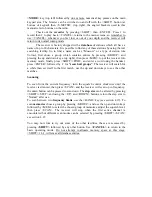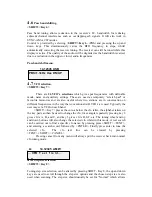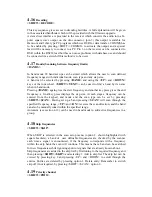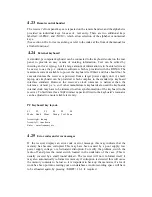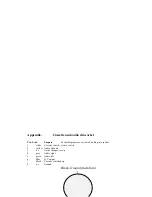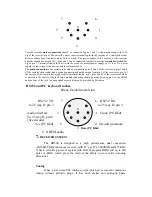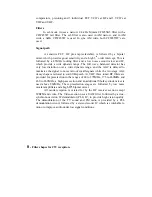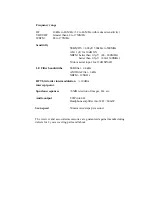
When “Prio” is activated in the <
SCAN><SET>
menu (option 3), the receiver
alternates between its normal scanning routine and the priority channel in order to
switch the receiver to the priority frequency as soon as the it becomes active. This
avoids having to wait for the frequency to occur in the scan sequence, which may take
some time to cycle through.
The priority channel is initially set up by pressing
<SHIFT><PRIO>.
Frequency,
mode and a name can then be entered.
Pr 12.34567 FMN
4.20
The database system.
a.
Memory records and group names
The database system provides 234 groups (A1 to Z9) which can each hold between 1
and 999 records although the maximum total number of records is limited to 13,290
with the standard 512K of RAM and 54,681 with the maximum of 2 Mbytes. These
figures are further reduced when the memory is partitioned for sound recording
(Section 4.14).
A memory can be created from a VFO frequency, (the normal tuning mode after
cancelling any other operation) as follows:
First select the desired group into which the memory is to be entered. This is done by
pressing
GROUP,
and using the up and down keys or the tuning wheel to change the
group number. Return to VFO mode by pressing
<CANCEL>
Set the frequency, mode and text field of the current VFO. Then press
<SHIFT>
<MEM>
(i.e. SAVE) and the record will be saved in the next available memory in
the current group.
The memories can be selected by pressing
<MEM>
and using the up and down keys
or the tuning wheel to move through the group. Pressing
<ENTER>
allows the
memory to be tuned,
<MEM>
returns to memory selection mode.
<GROUP>
can be
visited to show the group title.
Memory records
A1:1 14.12345 AMW
…Memory Text field…
Group names
A1:1 999 Entries
…Group Text Field…
Hint on use of memories…
Summary of Contents for RD500
Page 1: ......
Page 27: ...This graph shows the response curves for the CW filter selections 9 SPECIFICATIONS...
Page 31: ......


